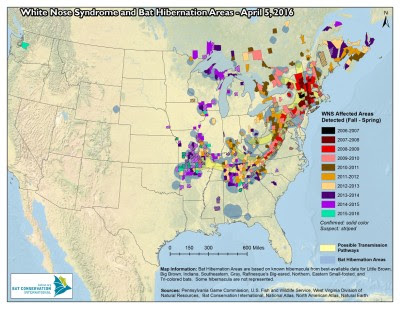First
Case Of White Nose  |
|
By
Patricia Doyle PhD |
| Hello Jeff - Well, we predicted this
day would happen and it has. White Nose Syndrome has now been confirmed
in North Bend, Washington state. White Nose is on the way to the Pacific
Ocean from the Atlantic, sea-to-sea and there is no stopping it. A very sad day indeed. Our bats are doomed. Patty First case of White Nose Syndrome West of the Rockies in North Bend, Washington. White-nose Syndrome in Western Bats? Posted by Avery Shawler, contracted field assistant for ICL at May 02, 2016 08:10 AM | Permalink On Mar 31, scientists confirmed the first case of white-nose syndrome west of the Rockies. It was discovered in a little brown bat (Myotis lucifugus) found by hikers along an undisclosed trail near North Bend, Wash., on Mar 11. The bat was very weak and unable to fly, so they took the bat to the Progressive Animal Welfare Society (PAWS) where it died two days later. Katie Haman, a veterinarian with the Washington Department of Fish and Wildlife, recognized the signs of WNS. After the bat died, the agency sent it to the U.S. Geological Survey’s (USGS) National Wildlife Health Center in Wisconsin, where scientists confirmed the disease. This is really scary news. Previously, the westernmost detection of the fungus was in Nebraska, almost 1,300 miles away. Katie Gillies, Director of Imperiled Species for Bat Conservation International, said in the USGS press release, “Such a massive jump in geographical location leads us to believe that we humans are most likely responsible for its most recent spread.” The fungus is transmitted primarily from bat to bat but can also spread when the spores of the fungus that causes WNS remain on the clothes and gear of recreational cavers and bat researchers. WNS does not affect humans or any other animals, but it is extremely important to decontaminate before and after visiting caves. Gillies told Darryl Fears at The Washington Post that now "we’re going to see it radiate from that new point. It’s like having breast cancer and finding that it’s metastasized.” She added, “We have as many as 16 western bat species that are now at risk. We have always feared a human-assisted jump to a western state. Unfortunately, our fears have been realized, and western North America—a bastion of bat biodiversity—may now expect impacts like we have seen in the East.” Bat map Updated map of white-nose bat syndrome in the U.S. BCI photo. “WNS is now recognized as one of the most devastating wildlife epidemics in recorded history,” Winifred Frick, Sebastien Puechmaille and Craig Willis, university researchers who work internationally, wrote in a 2016 paper. Bats are amazing animals that are essential to the environment, eating tons of insects nightly, thereby benefiting crops, forests and humans. The loss of bats in North America could lead to agricultural losses estimated at more than $3.7 billion a year. In Idaho, bats contribute an estimated value of over $313 million in pest control every year to the agricultural industry alone. Studying bats has also led to advancements in sonar, vaccine development, and blood coagulation. Spreading awareness about WNS and making sure to decontaminate before exploring caves are some of the ways you can help bats. If you're interested in other ways to help our bat friends, visit the Bat Conservation International website. In addition, the Idaho Department of Fish and Game details what is being done in Idaho. https://www.idahoconservation.org/blog/white-nose-syndrome-in-bats |
| Donate to Rense.com Support Free & Honest Journalism At Rense.com | Subscribe To RenseRadio! Enormous Online Archives, MP3s, Streaming Audio Files, Highest Quality Live Programs |